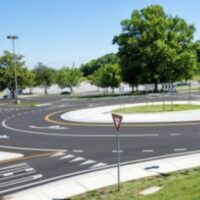Can Roundabouts Lower Car Accident Totals And Car Accident Severity?

Although they aren’t used much here in America, roundabouts are a staple of the roadways in many European countries. More and more, traffic planners here in America are advocating for roundabouts, claiming that they may be the answer to lowering car accidents and traffic fatalities.
What is a Roundabout?
A roundabout is where, in an intersection, there is no traffic light. Rather, the intersection of the roads happens when all roads meet in one, circular road (which can technically also be oval). Vehicles entering the roundabout yield to cars that are already in the roundabout, and traffic goes all in one direction (counterclockwise here in the US).
The roundabout has “exit points” or lanes, where drivers can get onto (or proceed on) whatever road that they want.
Studies Show Lowered Accident Rates
Although different studies yield different results, most studies have proven that roundabouts can lower traffic accidents by between 70-90%. This is from studies that have compared similar intersections that replaced traditional traffic lights with roundabouts.
Why are Roundabouts Safer?
There are a number of theories as to why roundabouts lower traffic incidents. Certainly, one obvious reason may be that traffic is flowing in one direction—there is no risk of head-on collisions, or sideswiping accidents. There are no red lights or stop lights to run (or speed up to beat). Roundabouts are also immune to power outages, which can make traffic-light intersections highly dangerous.
It is also nearly impossible to “miss” a roundabout. Unlike a tiny red light, which a distracted driver can overlook while driving at top speed, the roundabout is an actual change in the road’s pathway, something that is much harder for even a distracted driver to miss.
Roundabouts also actually move cars quicker and more efficiently, and thus, the reduction in stop and go traffic can reduce rear end collisions. Cars don’t stop in roundabouts the way they do at red lights, thus avoiding traffic backups.
Speed Lowers
But perhaps the biggest factor in the reduction of accidents is simply because cars slow down in roundabouts—they almost have to, as a car often can’t go on a turn as fast as it can on a straight line. Additionally, cars naturally slow down as a result of human nature and human factors. The driver slows down to enter the roundabout, and, knowing that the exit to the roundabout is approaching, often does not speed up again.
Slow cars means lower impact collisions, which means fewer injuries and fatalities, including fatalities to pedestrians, who fare much better when cars are going at slower speeds.
Although roundabouts can cause some problems—driver unfamiliarity is one—and although they do require more physical land than an intersection, many feel roundabouts may be the way to ease accidents at the more dangerous intersections in America.
Contact the Miami personal injury attorneys at Velasquez & Associates P.A. today. We can help you after a car accident in an intersection.
Sources:
wsdot.wa.gov/Safety/roundabouts/benefits.htm
.iihs.org/iihs/topics/t/roundabouts/qanda
